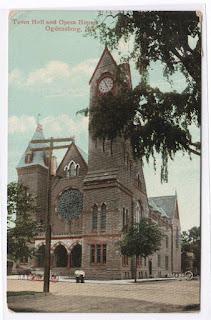On the night of Jan. 22, 1926 Ogdensburg and the Town of Oswegatchie suffered a terrible loss. The Opera House and Town Hall, the jewel of the North Country, was destroyed by fire. Built in 1879-80, the walls were of blue limestone with Potsdam sandstone trim. It was a Romanesque design with a duplicate of the Rose window of Reims Cathedral in France. The window faced the Ford Street side and was designed by famed Ogdensburg stained glass artist Harry Horwood. Romanesque design could be seen in the front rounded arches, barrel vaults, large towers, and thick walls.
The Opera House was built by the Town of Oswegatchie to house both town and city offices and the city police station and jail at a cost of $110,000. The building had a fully equipped theater to host concerts, vaudeville shows, high school graduations, plays and orators. Many famous people visited the edifice including women’s rights advocate Dr. Anna Howard Shaw, famed actress Rose Coghlan, future president Teddy Roosevelt, musician John Phillip Sousa, Sen. Chauncey Depew, national labor leader John Mitchell, Gov. Alfred E. Smith and Gov. Charles Whitman. Local politicians, Gen. N.M. Curtis and Sen. George Malby were nominated to serve in Congress from its stage. Artist Sally James Farnham also made appearances there, delighting audiences with her beautiful singing voice. But after the horrific fire, there would be no more concerts or speeches at Ogdensburg’s beautiful Opera House.
The Opera House opened Nov. 10, 1881, in a celebration that lasted two days. Attendees were treated to a concert by the Ogdensburg Band and a play, “School for Scandal," presented by a theater company from New York City. The next day another theater company presented two more plays to sold-out crowds. The Opera House became the center of arts and culture, not to mention city business, for over 40 years until the devastating fire on the night of Jan. 22, 1926.
The Republican Journal reported that at midnight on January 22nd the Gray and Cantwell families, who lived in apartments across the street, were awakened by a loud explosion. They reported that the interior of the building was engulfed in flames within 10 minutes. The wind carried sparks, and embers south several blocks endangering a number of buildings, but luckily it had snowed, which prevented the sparks from causing fire. The heat of the fire caused the plate glass windows in the St. Lawrence Utilities building located on Caroline Street to shatter, as well as the windows of stores across Ford Street. The firefighters on the scene quickly ascertained that saving the Opera House was impossible, so they concentrated their efforts on saving the surrounding buildings instead.
Several were in the building when the initial explosion took place. Janitor Thomas Preston and his wife were in their basement apartment. An unnamed newspaper reporter, Dr. C.R. Schultz, and Night Chief Dennis Amo were at the police station. Luckily there were no prisoners in jail and the movie crowd had left for the night. The movie “The Last Edition” that had been shown that night was coincidentally about a large fire.
As it burned, the building was unstable. Fire Chief Archie Howard was hit in the knee after a huge stone dropped from the west tower and fireman Henry Corrice was struck in the eye by a piece of slate or copper. Fire hoses were hit by flying debris and were unable to be used. The Republican Journal stated that “slate fell like hail…(and) a veritable hail of sparks descended from the sky south of Ford Street.”
Residents were devastated by the fire and especially the demise of the town hall bell. It was the gift of Louis Devillers Hoard, father of former mayor Charles Hoard. Many people and businesses kept time according to the chiming of the bell so its destruction meant that timekeeping was up to the individual. The bell, weighing 10 tons, fell at 1:45 a.m. Witnesses reported that it swayed in the tower before falling 150 feet, landing in the basement. A huge shower of sparks shot into the air.
The next day, a large ad was placed in the newspaper by insurance agent John H. Brownlow using the fire as a pretext to sell insurance. Not to be outdone, F.W. Ryan Insurance Agency and S.L. Dawley followed suit.
The Opera House was worth over $500,000, but was only insured for $69,000.The city had a lease for use of the building for 999 years at a cost of $1 per year. The fire ended that agreement and as a result, the town and city separated. Due to the insurance issue the present city hall was built in 1929 to house only city offices.
Two days after the fire the remains of the building were demolished. While initial reports suggested that the boiler had exploded, insurance investigators found that was not the case. No cause was ever found. Luckily, two safes were recovered and the records of the city were found intact, including the tax rolls. Also rescued from the ashes was the cornerstone of Fort de la Presentation. But the days of the grand, old Opera House were over and its loss was keenly felt by people throughout the north country.


Comments
Post a Comment